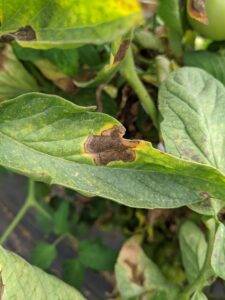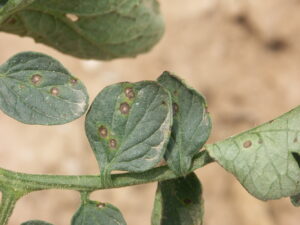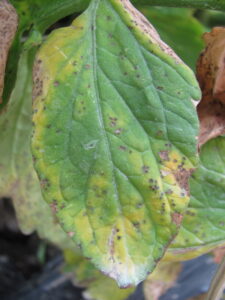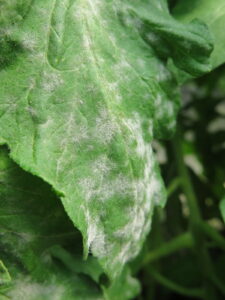Listed below are select foliar diseases of tomato.
Early blight and Septoria leaf blight-These diseases are listed together because, from a few paces away, the diseases appear similar. And the management for these diseases is similar. Together these diseases are probably the most common diseases of tomatoes in the field. One of the most common complaints I get about tomatoes is something like this…..’my tomatoes are turning brown from the ground up’. The most likely cause of this complaint is one of these diseases.
Early blight causes relatively large round necrotic lesions with concentric rings (Figure 1). The lesions tend to be gray-brown and are, as mentioned above, more common on the lower leaves of the plant. Septoria leaf blight lesions are also round but lack concentric rings. In addition, Septoria lesions have small, dark fungal structures in the lesions which may be seen with a 10X hand lens (Figure 2). Both diseases usually cause the lower leaves of the plant to become necrotic since older leaves tend to be more susceptible to these diseases.
Crop rotations of 3 to 4 years and fall tillage are important management decisions for both diseases. Currently, no commercial varieties have resistance to Septoria leaf blight. However, there are a few varieties with resistance to Early blight. Fungicides that are likely to be effective against these diseases are listed in the MW Vegetable Production Guide mwveguide.org. Contact products include fungicides with the active ingredient chlorothalonil (e.g., Bravo®, Echo®, Equus®, Initiate®) and mancozeb (e.g., Dithane®, Manzate®, Penncozeb®). Systemic fungicides include Aprovia Top®, Cabrio®, Fontelis®, Inspire Super®, Luna®, Priaxor®, Quadris®, Revus Top®, Rhyme®, Tanos® and Zing®. See the MW Vegetable Guide for details on rates, application instructions and formulation differences. Organic growers may find that fungicides that contain the active ingredient copper may help to reduce disease severity.
Bacterial spot of tomato has been observed across Indiana this summer. Leaf spots are usually 1/16 inch, and dark. Where lesions are numerous upon a leaf, the tissue may be chlorotic (yellow) (Figure 3). In contrast, each lesion of bacterial speck is often accompanied by chlorosis whether lesions are numerous or not. Lesions of bacterial spot on fruit are dark, raised and up to 1/3 inch in diameter. The disease prefers warm, wet weather. Overhead irrigation will also spread this disease.
Bacterial spot is much more common in field tomatoes than in greenhouse or high tunnel tomatoes. This is because bacterial spot requires leaf wetness for infection to take place and rain to spread the bacteria from leaf to leaf and from plant to plant. For the most part, tomato plants under cover lack sufficient leaf wetness to allow bacterial spot to become a problem.
You may have heard about bacterial spot of pepper and pumpkin. Bacterial spot of pepper is closely related and may be able to affect tomato. Bacterial spot of pumpkin will not affect pepper or tomato.
Successful management of bacterial spot will take a combination of cultural and pesticide treatments. Since bacterial spot may be seed borne; the disease may have been brought in on your seed/transplants. However, the causal bacterium also survives on crop residue. Tomatoes should be rotated 2 to 3 years away from peppers or tomatoes. Treatment with copper hydroxide may reduce spread in the field. Some strains of the bacterial spot pathogen are resistant to copper products. In a recent Purdue University study in 2016 and 2017, 84% of bacterial spot strains collected were copper insensitive (resistant). To increase the amount of copper available on the leaf, copper products may be mixed with fungicides with the active ingredient mancozeb (e.g., Dithane®, Manzate®, Penncozeb®). Many copper products may be used in some organic schemes.
Streptomycin products are labeled for use on tomatoes only in the transplant greenhouse (e.g., Agri-mycin®, Harbour®). The survey mentioned above found that 58% of bacterial spot strains were insensitive to streptomycin. So, it makes sense to treat with a streptomycin in the transplant greenhouse before going to the field.
Products with the active ingredient hydrogen dioxide (e.g., Oxidate®) are also labeled for bacterial spot in the field and greenhouse. Hydrogen dioxide can kill bacteria on contact, however, it has very little to no residual. Do not substitute hydrogen dioxide for copper, streptomycin or Actigard®. Be careful when mixing Oxidate® with other products. When used with copper products, for example, Oxidate® may not mix well. Read the labels of all the products carefully. Oxidate® may be used in some organic schemes.
Another product that has been used for management of bacterial spot of tomato is acibenzolar-S-methyl (trade name Actigard®). ASM is known as a systemic acquired resistance product. That is, it ‘tells’ the plant to turn on biochemical pathways that defend the plant from infection. ASM has been used with copper products to lessen the severity of bacterial spot of tomato. However, ASM can cause yield loss if used on tomatoes that are stressed due to drought or other environmental factors. The product Lifegard® has a similar mode of action to Actigard®. Serenade Opti® (an older name for this product is Serenade Max®) is labeled against bacterial spot of tomato. The action of Serenade Opti® is reported to be due to a protein component of the bacterial ingredient and to a systemic acquired resistance activity similar to that described for ASM. Both Lifegard® and Serenade Opti® may be accepted for some organic certifications.
Powdery mildew of tomato is not usually a common problem in Indiana. However, in recent years, there have been more reports of this disease than usual. Powdery mildew is more often observed in a greenhouse or high tunnel situation than in a field.
The key symptoms of this disease are the talc-like lesions on the upper and lower leaf surfaces (Figure 4). It is important to note that the location of the upper and lower lesions do not correspond with each other. When the lesions are young, it may almost seem as if the lesions can be ‘wiped off’.
Few varieties exist with good levels of host resistance, although growers may notice some difference in susceptibility between varieties.
It may not be necessary to treat tomatoes affected with powdery mildew with fungicides. If fungicide treatment appears to be warranted, a few alternatives are: Fontelis®, Inspire Super®, Quadris Top®, several formulations of sulfur, Switch® and Vivando®. The products listed are all either labeled for the greenhouse or silent about greenhouse use. Check the label carefully before using any of these products.



